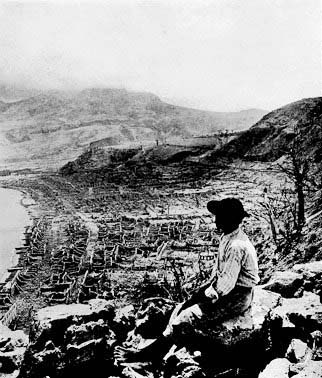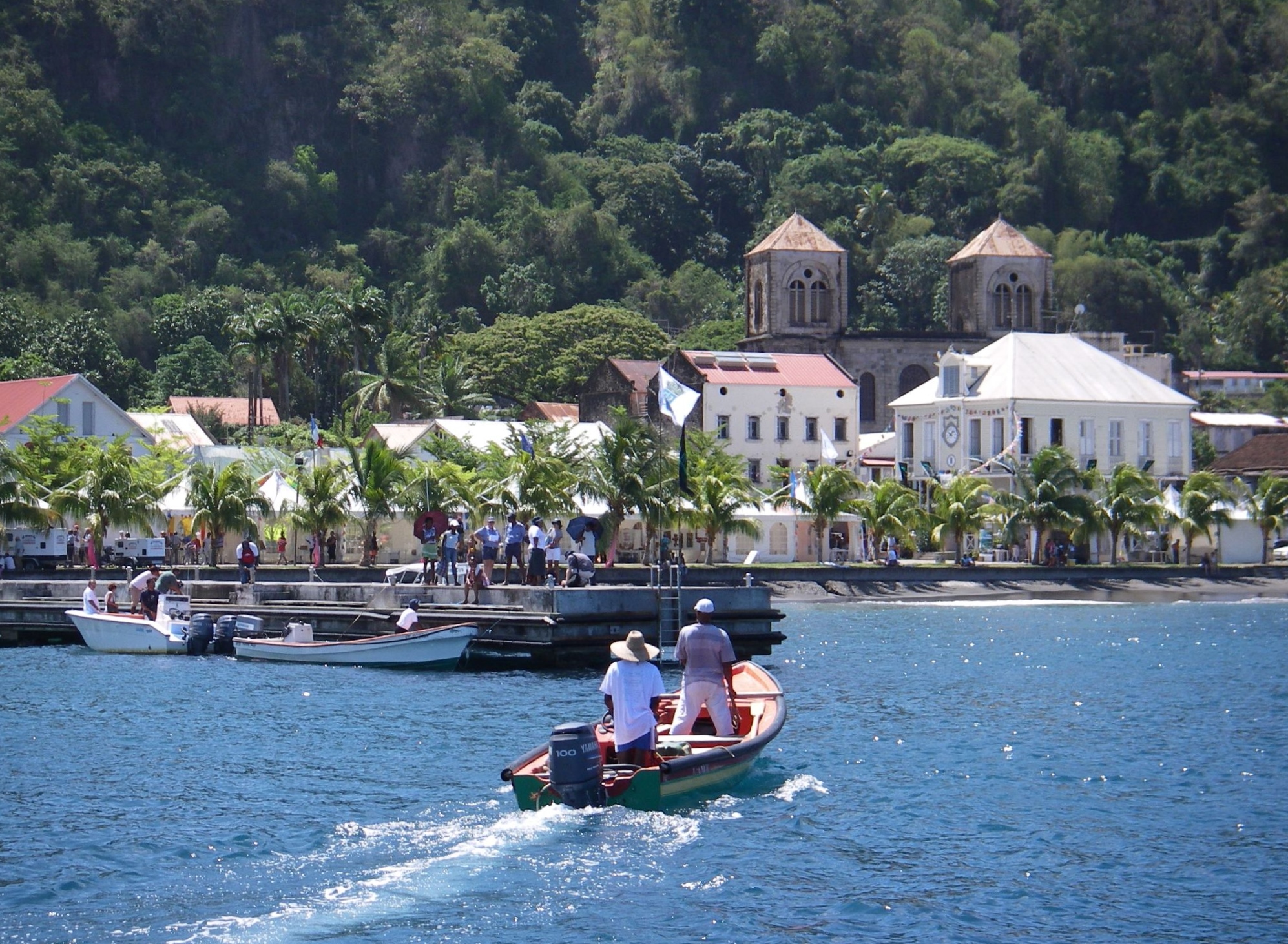Saint-Pierre, Martinique (seen from the harbor - 2005-06-15).jpg on:
[Wikipedia]
[Google]
[Amazon]
Saint-Pierre (, ; ; Martinican Creole: ) is a town and commune of France's



 The town was again destroyed in 1902, when the volcano Mount Pelée erupted, killing 28,000 people. The entire population of the town, as well as people from neighboring villages who had taken refuge in the supposedly safe city, died, except for three people—a young girl, Havivra da Ifrile, a prisoner by the name of Louis-Auguste Cyparis (known also by various other names), who later toured the world with the Barnum and Bailey Circus, and Léon Compère-Léandre, who lived at the edge of the city.
Legend has it that the town's doom was forecast by loud groaning noises from within the volcano, but the mayor of the town had it blocked off to prevent people from leaving during an election. This story appears to have originated with one of the island's newspapers, published by a political opponent of the governor. Actually, there was considerable eruptive activity in the two weeks prior to the fatal blast, but since the phenomenon of the pyroclastic flow (french: nuée ardente) was not yet understood, the danger was perceived to be from lava flows, which, it was believed, would be stopped by two valleys between the volcano and the city.
The town was again destroyed in 1902, when the volcano Mount Pelée erupted, killing 28,000 people. The entire population of the town, as well as people from neighboring villages who had taken refuge in the supposedly safe city, died, except for three people—a young girl, Havivra da Ifrile, a prisoner by the name of Louis-Auguste Cyparis (known also by various other names), who later toured the world with the Barnum and Bailey Circus, and Léon Compère-Léandre, who lived at the edge of the city.
Legend has it that the town's doom was forecast by loud groaning noises from within the volcano, but the mayor of the town had it blocked off to prevent people from leaving during an election. This story appears to have originated with one of the island's newspapers, published by a political opponent of the governor. Actually, there was considerable eruptive activity in the two weeks prior to the fatal blast, but since the phenomenon of the pyroclastic flow (french: nuée ardente) was not yet understood, the danger was perceived to be from lava flows, which, it was believed, would be stopped by two valleys between the volcano and the city.

City of Saint-Pierre description from English edition of official Martinique website
{{DEFAULTSORT:Saintpierre Communes of Martinique Subprefectures in France Populated places in Martinique Populated places established in 1635 1635 establishments in the French colonial empire
Caribbean
The Caribbean (, ) ( es, El Caribe; french: la Caraïbe; ht, Karayib; nl, De Caraïben) is a region of the Americas that consists of the Caribbean Sea, its islands (some surrounded by the Caribbean Sea and some bordering both the Caribbean Se ...
overseas department
The overseas departments and regions of France (french: départements et régions d'outre-mer, ; ''DROM'') are departments of France that are outside metropolitan France, the European part of France. They have exactly the same status as mainlan ...
of Martinique, founded in 1635 by Pierre Belain d'Esnambuc. Before the total destruction of Saint-Pierre by a volcanic eruption in 1902, it was the most important city of Martinique culturally and economically, being known as "the Paris of the Caribbean". While Fort-de-France
Fort-de-France (, , ; gcf, label=Martinican Creole, Fodfwans) is a Communes of France, commune and the capital city of Martinique, an overseas department and region of France located in the Caribbean. It is also one of the major cities in the ...
was the official administrative capital, Saint-Pierre was the cultural capital of Martinique. After the disaster, Fort-de-France grew in economic importance.
History
Saint-Pierre was founded in 1635 by Pierre Belain d'Esnambuc, aFrench
French (french: français(e), link=no) may refer to:
* Something of, from, or related to France
** French language, which originated in France, and its various dialects and accents
** French people, a nation and ethnic group identified with Franc ...
trader and adventurer, as the first permanent French colony on the island of Martinique.
The Great Hurricane of 1780 produced a storm-surge of which "inundated the city, destroying all houses" and killed 9,000 people.

Eruption of Mount Pelée


 The town was again destroyed in 1902, when the volcano Mount Pelée erupted, killing 28,000 people. The entire population of the town, as well as people from neighboring villages who had taken refuge in the supposedly safe city, died, except for three people—a young girl, Havivra da Ifrile, a prisoner by the name of Louis-Auguste Cyparis (known also by various other names), who later toured the world with the Barnum and Bailey Circus, and Léon Compère-Léandre, who lived at the edge of the city.
Legend has it that the town's doom was forecast by loud groaning noises from within the volcano, but the mayor of the town had it blocked off to prevent people from leaving during an election. This story appears to have originated with one of the island's newspapers, published by a political opponent of the governor. Actually, there was considerable eruptive activity in the two weeks prior to the fatal blast, but since the phenomenon of the pyroclastic flow (french: nuée ardente) was not yet understood, the danger was perceived to be from lava flows, which, it was believed, would be stopped by two valleys between the volcano and the city.
The town was again destroyed in 1902, when the volcano Mount Pelée erupted, killing 28,000 people. The entire population of the town, as well as people from neighboring villages who had taken refuge in the supposedly safe city, died, except for three people—a young girl, Havivra da Ifrile, a prisoner by the name of Louis-Auguste Cyparis (known also by various other names), who later toured the world with the Barnum and Bailey Circus, and Léon Compère-Léandre, who lived at the edge of the city.
Legend has it that the town's doom was forecast by loud groaning noises from within the volcano, but the mayor of the town had it blocked off to prevent people from leaving during an election. This story appears to have originated with one of the island's newspapers, published by a political opponent of the governor. Actually, there was considerable eruptive activity in the two weeks prior to the fatal blast, but since the phenomenon of the pyroclastic flow (french: nuée ardente) was not yet understood, the danger was perceived to be from lava flows, which, it was believed, would be stopped by two valleys between the volcano and the city.

Climate
Temperature record
On 6 October 2010, Saint-Pierre recorded a temperature of , which is the highest temperature to have ever been recorded in Martinique.Climate data of Saint-Pierre
Saint-Pierre has a tropical monsoon climate ( Köppen climate classification ''Am''). The average annual temperature in Saint-Pierre is . The average annual rainfall is with August as the wettest month. The temperatures are highest on average in August, at around , and lowest in January, at around . The highest temperature ever recorded in Saint-Pierre was on 6 October 2010; the coldest temperature ever recorded was on 3 February 2005.Population
Today
The city of Saint-Pierre was never restored to its former entirety, though some villages were built in later decades on its place. Today, the town is the seat of the Arrondissement of Saint-Pierre. It has been designated as a " City of Art and History". There are many historic remains, and a Volcanological Museum ().See also
* Co-Cathedral of Our Lady of Assumption, Saint-Pierre *Communes of the Martinique department
The following is a list of the 34 communes of the Martinique overseas department of France.
The communes cooperate in the following intercommunalities (as of 2020):Herculaneum
Herculaneum (; Neapolitan and it, Ercolano) was an ancient town, located in the modern-day ''comune'' of Ercolano, Campania, Italy. Herculaneum was buried under volcanic ash and pumice in the eruption of Mount Vesuvius in AD 79.
Like the nea ...
*Pompeii
Pompeii (, ) was an ancient city located in what is now the ''comune'' of Pompei near Naples in the Campania region of Italy. Pompeii, along with Herculaneum and many villas in the surrounding area (e.g. at Boscoreale, Stabiae), was buried ...
*Victor Cochinat
Jean-Baptiste-Thomas-Victor Cochinat (19 January 1819 – October 1886) was a 19th-century French lawyer, journalist and man of letters. He authored political articles under the pseudonyms Maxime Leclerc, Louis de Roselay etc. He was Chief editor ...
(1819–1886), French journalist
* Georges Hébert (1875–1957), French naval officer who witnessed the destruction by the volcano on the island in 1902, and went on to develop a physical training method from his experience
References
External links
*City of Saint-Pierre description from English edition of official Martinique website
{{DEFAULTSORT:Saintpierre Communes of Martinique Subprefectures in France Populated places in Martinique Populated places established in 1635 1635 establishments in the French colonial empire